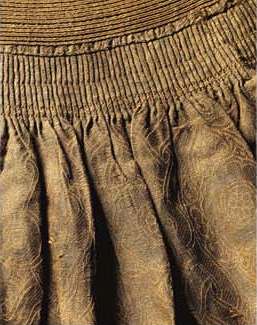I'm multi-talented, or maybe ADD, like that. I like to think multi-talented, but sometimes I get bored and my interests wander off to something which isn't my main focus for a while.
I want to make something inspired by this:
 |
| source |
First, the general construction of Mongol deels hasn't really changed much over the passing centuries. I believe I've talked to the basic construction before, but in case I haven't, the general pattern I have memorized is here. I do some modifications, like I will take out the panel extensions because of the fit I usually do, which is loose in the lower half, but you can see the basics of it in any of the pictures of me I've posted up here for head-to-toe analysis and the like.
Now, unsurprising to most people who study it, but history is messy. People then, like now, don't fall into these discrete and easy groupings, and with that, comes variations across.
In China, the strong influence of the Chinese ethnic groups means that I generally haven't seen the deels like the above. They tend to be less fitted, longer and more simple in design and construction, relying on the strength and prominence of the fabric to do the talking.
The example above, is from the Persian sphere of influence. What that means is that the Mongols changed their deel a bit, the longer they were there, until it becomes the cross-over coat that the early Mughals wore, at least until Period ends in the early 17th century.
It looks like this:
 |
| source |
First, a close up of the pleating:
 |
| Same source as extant at beginning |
I was talking with Elvira yesterday about garb fantasies and my sticking points. And there are two with this particular deel construction.
The pleats and the belt. The belt I'll get to in a minute, but the pleats I want to dive into more.
They way they sit they look like cartridge pleats. I've laid out cartridge pleats for other members of the household's garb. I know how to do it, but I have literally no evidence (there's no inside detail shot I can find) that this is, in fact, a type of cartridge pleat.
It's insanely neat and ordered, but without the evidence for cartridge pleating, I have to believe it's probably insanely small, and well organized, gathers. They appear to be sewn in 3 spots: one to the upper part of the coat, one in the center and then one a bit further down to reinforce the drape. Kind of like a proto-smocking, I suppose.
However, I really am not sure. I'll have to experiment, and likely fail, a few times before I work it out.
Now the belt.
That belt is a braided in small, smell braids, then sewn together. As a belt, it is not part of the actual coat itself, but holds it together between the waist and the hips. That's a lot of braiding. I don't braid well. That's a problem.
So, I've got some working out to do, which will require some experimentation. I would not expect as much about this ongoing experiment that I would about the other project, as it's more clear-cut in when I can start and stop, and what that will look like in terms of progress.
No comments:
Post a Comment